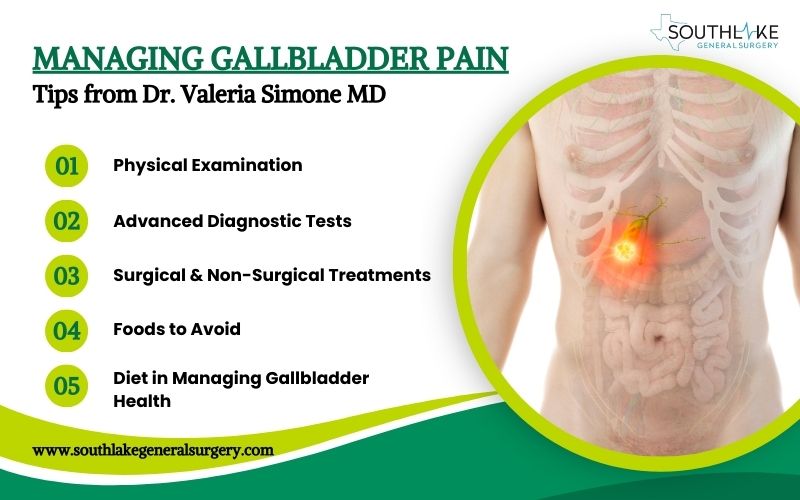Gallbladder pain is a severe condition that impacts numerous people. Located in the upper right portion of the abdomen, the gallbladder plays a crucial role in digestion by storing and releasing bile, a digestive fluid produced by the liver.
When problems occur with the gallbladder, like gallstones or inflammation, it can result in intense pain and discomfort. Understanding the causes and treatment options for gallbladder pain is essential for Southlake residents who may be experiencing these symptoms.
In this blog, we will explore the various aspects of gallbladder pain, including its causes, common symptoms, and treatment options available at Southlake General Surgery. We will also discuss the importance of diagnosing gallbladder issues and provide guidelines for preparing for gallbladder surgery.
Additionally, we will touch upon the role of diet in managing gallbladder health, including foods to avoid and recommended dietary changes post-surgery. Finally, we will address frequently asked questions related to gallbladder pain to provide readers with a comprehensive understanding of this condition.
By delving into these topics, we hope to provide valuable information that will help Southlake residents better understand gallbladder pain and make informed decisions about their health.
Key Highlights
- Gallbladder pain is often caused by gallstones, which are hardened deposits of bile that can form in the gallbladder.
- Common symptoms of gallbladder pain include severe pain in the upper right abdomen, pain in the right shoulder, and nausea or vomiting.
- Gallstones are the main reason for gallbladder pain among Southlake residents, often resulting from high levels of cholesterol or bilirubin in the bile.
- Diagnosing gallbladder issues may involve a physical examination, patient history, and advanced diagnostic tests such as an HIDA scan and a CT scan.
- Treatment options for gallbladder pain in Southlake include non-surgical treatments such as dietary changes and lifestyle adjustments, as well as laparoscopic gallbladder surgery.
- Preparing for gallbladder surgery involves pre-operative care and providing health information to your healthcare provider.
- Post-operative care and recovery after gallbladder surgery may involve managing post-surgery complications and following a healthy diet.
- To prevent or alleviate gallbladder pain, it is important to follow a healthy diet, maintain a healthy weight, and manage pain effectively.
- Opt for foods low in cholesterol and unhealthy fats to support gallbladder health, and explore a high-fiber, digestion-friendly diet post-surgery.
- It is important to seek medical attention for gallbladder pain if you experience severe pain or symptoms of a gallbladder attack, or if you have concerns about your gallbladder health.
- Frequently asked questions about gallbladder pain include inquiries about the seriousness of gallbladder pain, non-surgical treatment options, the success rate of laparoscopic gallbladder surgery, and when to seek medical attention for gallbladder pain.
Understanding Gallbladder Pain
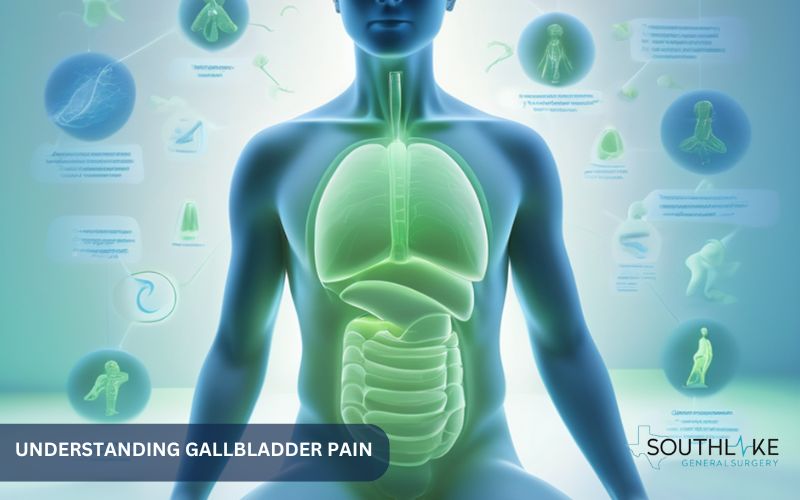
Gallbladder pain refers to the discomfort or pain experienced in the upper right abdomen, typically caused by problems with the gallbladder. Situated beneath the liver is a small, pear-shaped organ known as the gallbladder. It stores bile, a digestive fluid necessary for the breakdown of fats.
Gallbladder pain can arise from different conditions, such as gallstones, gallbladder inflammation (cholecystitis), or other gallbladder diseases. The pain is often described as sharp or cr-like and may radiate to the back or right shoulder. Additional symptoms like nausea, vomiting, and fever may accompany gallbladder pain.
If you are experiencing persistent or severe abdominal pain, it is important to seek medical attention to determine the cause and appropriate treatment for your gallbladder pain. Understanding the underlying causes of gallbladder pain can help in the diagnosis and management of this condition.
What is Gallbladder Pain?
Gallbladder pain refers to the discomfort or pain that originates from the gallbladder, a small organ located on the right side of the abdomen, just beneath the liver. The gallbladder plays a crucial role in digestion by storing bile, a digestive fluid produced by the liver, and releasing it into the small intestine to aid in the breakdown of fats. When the gallbladder becomes inflamed or gallstones form, it can lead to pain and discomfort.
Pain related to gallbladder problems is typically experienced in the upper right abdomen and might spread to the back or right shoulder. This pain may be triggered by factors such as eating fatty or greasy foods. When gallstones block the bile ducts, it can cause intense pain and other symptoms. Understanding the nature of gallbladder pain is important for diagnosing and treating gallbladder issues effectively.
Common Symptoms and Warning Signs
The sudden onset of severe pain in the upper right abdomen or right shoulder blade, especially after a meal, is a key symptom of gallbladder pain. This discomfort can radiate to the back and worsen with deep breaths. Nausea, vomiting, and abdominal bloating are also common.
Pay attention to persistent pain lasting more than a few hours or associated with fever, chills, or yellowing of the skin or eyes, as these could indicate a more serious condition requiring immediate medical attention.
Causes of Gallbladder Pain in Southlake Residents
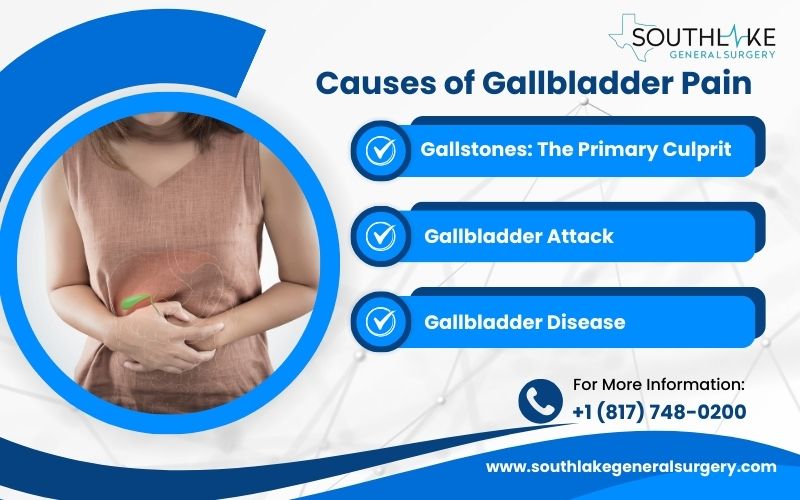
Gallbladder pain in Southlake residents primarily stems from gallstones, which can block the bile ducts and lead to inflammation. Additionally, factors like gallbladder disease and acute cholecystitis contribute to the discomfort experienced.
When the gallbladder contracts forcefully due to these issues, it can result in severe pain on the right side of the abdomen. Seeking medical attention for symptoms like sharp pain in the upper right abdomen or right shoulder blade is crucial for proper diagnosis and treatment.
Gallstones: The Primary Culprit
Gallstones, the main cause of gallbladder pain, are solid particles that form in the gallbladder due to an imbalance in bile components. These stones can range in size from a grain of sand to a golf ball and can block the bile ducts, leading to severe pain.
Cholesterol gallstones, the most common type, form when there’s too much cholesterol in the bile, while pigment stones develop when there’s an excess of bilirubin. Understanding the type of gallstone is crucial in determining the appropriate treatment plan.
Gallbladder Attack
During a gallbladder attack, the sudden onset of intense pain can be overwhelming. This excruciating pain is often accompanied by nausea, vomiting, and even fever. It’s a distressing experience that requires immediate medical attention to alleviate symptoms and prevent complications.
Understanding the triggers and symptoms of a gallbladder attack can help in effectively managing this condition and avoiding future episodes. Early intervention is key to mitigating the impact of gallbladder attacks on overall health and well-being.
Symptoms of Gallbladder Attack
Symptoms of a gallbladder attack can be severe, with intense pain as the key indicator. Nausea, vomiting, and fever often accompany the pain, making it a distressing experience. Recognizing these symptoms early on is crucial for timely medical intervention to alleviate discomfort and prevent complications. Proper management of gallbladder attacks involves understanding the triggers and addressing them effectively to ensure better health outcomes and reduced recurrence rates.
Other Contributing Factors
Gallbladder pain may not only result from gallstones but can also be caused by other factors. Severe pain on the right side can be a symptom of acute cholecystitis, which is inflammation of the gallbladder. Gallbladder disease or gallbladder inflammation may trigger discomfort in the upper right abdomen. Biliary colic, characterized by sharp pain, could also contribute to the distress.
It’s crucial to identify these additional factors, apart from gallstone-related issues, to ensure an accurate diagnosis and an appropriate treatment plan. Management may involve addressing these diverse contributing elements for comprehensive care.
Diagnosing Gallbladder Issues
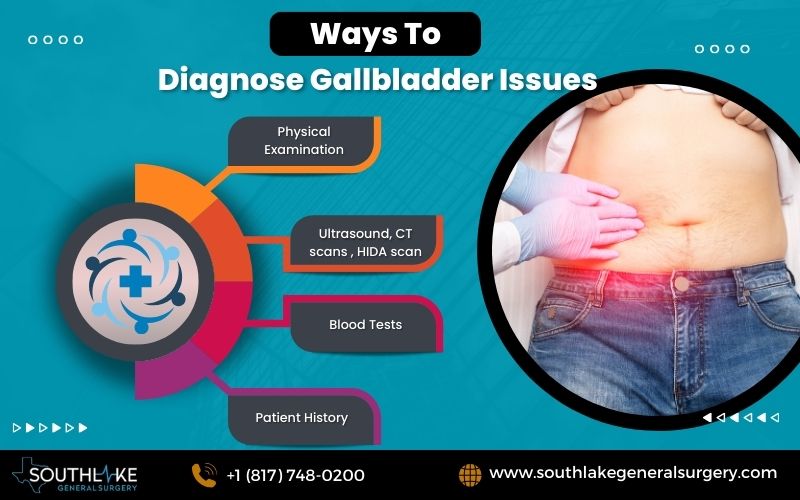
Imaging tests like ultrasound and CT scans can help diagnose gallbladder problems. These tests can detect gallstones, inflammation, or other issues. Blood tests may reveal elevated liver enzymes or signs of infection. A HIDA scan evaluates gallbladder function by tracking the flow of bile.
For a comprehensive diagnosis, your healthcare provider may recommend an endoscopic retrograde cholangiopancreatography (ERCP) to examine the bile ducts closely. Seeking medical attention for persistent right-sided abdominal pain is crucial for accurate diagnosis and timely treatment.
Physical Examination and Patient History
Physical examination and patient history are crucial in diagnosing gallbladder issues. A healthcare provider will assess symptoms like abdominal pain, especially in the upper right side, and may inquire about factors such as diet and recent weight loss.
Additionally, they will review past medical history to understand any predisposing conditions or previous gallbladder problems. This information helps determine the necessary diagnostic tests for an accurate diagnosis. These initial steps pave the way for effective treatment planning at Southlake General Surgery.
Advanced Diagnostic Tests
Advanced diagnostic tests for gallbladder issues typically include procedures like HIDA scans, CT scans, and endoscopic retrograde cholangiopancreatography (ERCP). These tests help in identifying the underlying causes of gallbladder pain by providing detailed images of the gallbladder, bile ducts, and surrounding areas.
HIDA scans assess the function of the gallbladder and how well it releases bile, while CT scans offer cross-sectional images for a comprehensive evaluation. ERCP enables visualization of the bile and pancreatic ducts, aiding in accurate diagnosis and treatment planning.
Treatment Options Available at Southlake General Surgery
At Southlake General Surgery, treatment options for gallbladder pain are comprehensive. Non-surgical approaches and lifestyle modifications are initially considered to manage symptoms.
When surgical intervention is required, Dr. Valeria Simone MD, specializes in laparoscopic gallbladder surgery, ensuring minimal invasiveness and quicker recovery times for patients. Patients can trust the expertise of the medical professionals at Southlake General Surgery for personalized care tailored to their specific gallbladder issues.
Non-Surgical Treatments and Lifestyle Adjustments
For individuals with gallbladder pain in Southlake, non-surgical approaches and lifestyle modifications play a crucial role in managing symptoms. Dietary adjustments, including avoiding fatty foods and maintaining a healthy weight, can help alleviate discomfort.
Additionally, medications to dissolve gallstones may be prescribed. Engaging in regular exercise and adopting a balanced diet can contribute to overall gallbladder health, reducing the likelihood of severe pain episodes. These non-invasive methods offer effective alternatives to surgical intervention, promoting comfort and well-being.
Laparoscopic Gallbladder Surgery by Dr. Valeria Simone MD
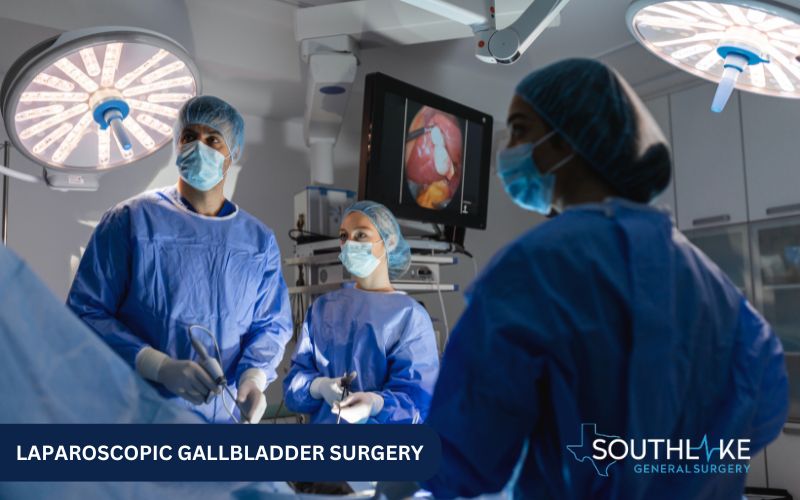
Laparoscopic gallbladder surgery, conducted by Dr. Valeria Simone MD, is a minimally invasive procedure utilized to remove the gallbladder. This advanced technique involves small incisions, reducing scarring and promoting quicker recovery times.
Dr. Valeria Simone MD specializes in utilizing laparoscopic methods to address gallbladder issues effectively. Patients benefit from shorter hospital stays and less post-operative discomfort compared to traditional open surgery. This approach ensures a smoother surgical experience and a faster return to daily activities.
Preparing for Gallbladder Surgery
Prior to gallbladder surgery, it’s essential to follow preoperative instructions provided by your healthcare provider. This may involve fasting before the procedure and ensuring you have someone available to drive you home post-surgery. It’s crucial to inform your medical team about any medications or supplements you are taking.
Understanding the potential risks and benefits of the surgery can help alleviate concerns and prepare you for a smoother recovery process. Discuss any questions or apprehensions with your healthcare provider for a well-informed approach.
What to Expect Before the Procedure
Before the procedure, patients can expect a discussion with their surgeon regarding the details of the operation and any potential risks involved. Tests may be conducted to ensure optimal health for surgery, including blood work and imaging scans.
Patients will likely receive instructions on fasting before the procedure and guidance on medications. It is important to follow pre-operative guidelines diligently to ensure a smooth process and reduce any complications during surgery.
Post-Operative Care and Recovery
After gallbladder surgery, post-operative care is critical for a smooth recovery. Patients should follow the surgeon’s instructions diligently, manage pain with prescribed medications, and gradually resume normal activities. It is crucial to get sufficient rest and take care of wounds properly.
It’s crucial to watch for any signs of infection or complications and contact the healthcare provider if any concerns arise. Maintaining a healthy diet, staying hydrated, and slowly reintroducing physical activity are key components of successful recovery.
Potential Complications and How to Avoid Them
Potential complications following gallbladder surgery include bile duct injury, infection, and bleeding. To minimize risks, it’s crucial to follow post-operative care instructions meticulously. Watch for signs of infection, like fever or redness. Maintain a healthy weight, as rapid weight loss can trigger gallstone formation.
Immediate medical attention should be sought if you are experiencing severe pain. Adhere strictly to dietary guidelines post-surgery to prevent bile buildup and complications. Regular follow-ups with your healthcare provider are essential for monitoring your recovery.
Common Post-Surgery Complications
After gallbladder removal surgery, typical postoperative complications may involve temporary diarrhea or loose stools as the body adapts to the gallbladder’s absence. Some individuals may experience changes in bowel habits, particularly with fatty foods.
In rare cases, individuals may develop a condition called post-cholecystectomy syndrome, characterized by ongoing abdominal pain, bloating, or indigestion. It’s essential to promptly address any persistent or severe symptoms and follow up with your healthcare provider for proper management.
Tips for a Smooth Recovery
It is essential to follow post-operative instructions carefully for a smooth recovery after gallbladder surgery. Stay hydrated, gradually reintroduce solid foods, and avoid heavy lifting. Listen to your body, rest adequately, and engage in light activities to aid recovery.
Contact your healthcare provider if you experience prolonged pain, fever, or unusual symptoms. Adhering to these tips can promote a quicker and smoother healing process, ensuring a successful outcome.
The Role of Diet in Managing Gallbladder Health

Maintaining a healthy diet plays a crucial role in managing gallbladder health. To support your gallbladder, opt for a diet low in fat and cholesterol. Include high-fiber foods like fruits, vegetables, and whole grains to aid digestion and regulate bowel movements. Stay hydrated and limit sugary beverages. Avoid fried, greasy, and processed foods as they can trigger gallbladder issues.
By making mindful dietary choices, you can promote better gallbladder function and reduce the risk of complications.
Foods to Avoid
Foods high in fat, especially fried and greasy dishes, can trigger gallbladder pain. Avoid heavy meals and rich sauces that can overwork your gallbladder. Spicy foods and dairy products may also exacerbate symptoms.
Additionally, steering clear of processed foods and sugary treats can benefit those with gallbladder issues. Maintaining a diet low in cholesterol and refined carbohydrates is key to managing gallbladder pain effectively.
Recommended Diet Post-Surgery
After gallbladder surgery, Southlake General Surgery advises a gradual return to a normal diet. Start with clear liquids before moving to low-fat, easily digestible foods like lean proteins, fruits, vegetables, and whole grains.
Avoid fried, fatty, and spicy foods initially. Stay hydrated and prioritize small, frequent meals to aid digestion. Limit caffeine and alcohol intake. Consult with your healthcare provider for personalized dietary recommendations tailored to your recovery and overall health.
Conclusion
In conclusion, understanding gallbladder pain and its treatment options is crucial for managing this condition effectively. Whether caused by gallstones or other factors, seeking a timely diagnosis and appropriate treatment is key to alleviating discomfort and preventing complications.
With advanced diagnostic tests and surgical interventions available at Southlake General Surgery, individuals experiencing gallbladder pain can rest assured that tailored care and support are within reach.
Prioritizing your gallbladder health through lifestyle adjustments, a balanced diet, and expert medical guidance can significantly improve your quality of life. If you have any concerns or symptoms related to gallbladder issues, don’t hesitate to make an appointment with our experienced team at Southlake General Surgery. Your well-being is our priority.
A Note From Southlake General Surgery
At Southlake General Surgery, we prioritize your well-being. Our experienced team is dedicated to providing top-notch care for gallbladder issues. Our specialists are ready to support you from diagnosis to recovery, whether you’re experiencing abdominal discomfort due to gallbladder disease or inflammation.
From dietary advice to advanced surgical interventions, we offer comprehensive solutions tailored to your needs. Trust us to deliver personalized care and support you every step of the way. Your journey to better gallbladder health starts here.
Make an Appointment
To schedule a consultation or seek additional information regarding gallbladder pain management, please contact Southlake General Surgery. It is crucial to address any concerning symptoms promptly to prevent potential complications.
Our experienced team provides personalized care tailored to your specific needs. Make an appointment today at +1 (817) 748-0200 to discuss treatment options and take proactive steps toward managing your gallbladder health effectively. Your well-being is our priority.
Frequently Asked Questions
How do I know if my gallbladder pain is serious?
Seek immediate medical attention if your gallbladder ache is severe, lasts more than a few hours, or is accompanied by fever, chills, or yellowing of the skin. These could indicate a serious issue that requires prompt evaluation by a healthcare professional.
Can gallbladder pain be managed without surgery?
While some cases of gallbladder discomfort may require surgery, non-surgical options like dietary changes and medication can help manage symptoms for some individuals. Consulting with a healthcare provider is crucial to determining the best course of action.
What is the rate of success for laparoscopic gallbladder surgery?
Laparoscopic gallbladder surgery boasts a high success rate, with minimal scarring and quicker recovery times compared to traditional open surgery. Success rates vary but generally range from 85-95%. This minimally invasive approach is favored for its effectiveness and patient outcomes.
At what point should I consult a healthcare provider for gallbladder pain?
Seek medical attention for gallbladder pain if you experience severe abdominal pain, nausea, vomiting, or jaundice. Any unexplained, persistent symptoms warrant a doctor’s evaluation to rule out serious conditions. Early intervention is key to managing gallbladder issues effectively.
What lifestyle changes can help manage gallbladder pain?
Making lifestyle changes, such as adopting a low-fat diet, maintaining a healthy weight, and staying hydrated, can help manage gallbladder pain. Regular exercise and avoiding trigger foods like fried or spicy dishes are also beneficial.
Are there any dietary recommendations to prevent or alleviate gallbladder pain?
Consuming low-fat, high-fiber diet rich in fruits, vegetables, and whole grains can help prevent gallbladder pain. Avoiding fried foods, spicy dishes, and excessive dairy products may alleviate symptoms. Adequate hydration and maintaining a healthy weight are also crucial.
Medically Reviewed By: Dr. Valeria Simone MD
Board-certified General Surgeon at Southlake General Surgery, Texas, USA.
Follow us on Facebook and YouTube.
References:
- Jones, M. W., Genova, R., & O’Rourke, M. C. (2023, May 22). Acute Cholecystitis. StatPearls – NCBI Bookshelf. https://www.ncbi.nlm.nih.gov/books/NBK459171/
- Shin Y, Choi D, Lee KG, Choi HS, Park Y. Association between dietary intake and postlaparoscopic cholecystectomic symptoms in patients with gallbladder disease. Korean J Intern Med. 2018;33(4):829-836. doi:10.3904/kjim.2016.223
- Mansour S, Kluger Y, Khuri S. Primary Recurrent Common Bile Duct Stones: Timing of Surgical Intervention. J Clin Med Res. 2022;14(11):441-447. doi:10.14740/jocmr4826
- Anand AK, Pilala P, Balachandra SS, Sawant PS, Prasad R, Rao BC. Managing a case of acute calculous cholecystitis at home: Highlighting the role of family physicians in providing home-based care. J Family Med Prim Care. 2019;8(7):2548-2550. doi:10.4103/jfmpc.jfmpc_259_19
- Quoraishi S, Ahmed J, Ponsford A, Rasheed A. Lessons learnt from a case of extracorporeal shockwave lithotripsy for a residual gallbladder stone. Int J Surg Case Rep. 2017;32:43-46. doi:10.1016/j.ijscr.2017.02.001
- Hassler, K. R., Collins, J. T., Philip, K., & Jones, M. W. (2023, January 23). Laparoscopic Cholecystectomy. StatPearls – NCBI Bookshelf. https://www.ncbi.nlm.nih.gov/books/NBK448145/
- Bass, G. A., Gilani, S. N. S., Walsh, T. N., & Leader, F. (2013, August 9). Validating the 5Fs mnemonic for cholelithiasis: time to include family history. Postgraduate Medical Journal. https://doi.org/10.1136/postgradmedj-2012-131341

